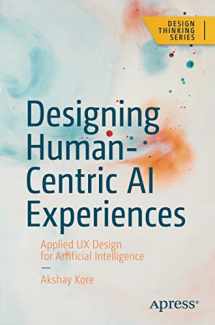
Designing Human-Centric AI Experiences: Applied UX Design for Artificial Intelligence (Design Thinking)
Book details
Summary
Description
User experience (UX) design practices are evolving as more and more software products incorporate machine learning (ML) components and artificial intelligence (AI) algorithms at their core.
AI brings a fundamental shift to how we design products. Instead of programming a system to do a specific action, AI teams are responsible for curating outcomes based on algorithms and large amounts of data. AI systems are dynamic, they change over time, and their user experience needs to adapt to this change. The complexity of these systems requires deeper collaborations with various disciplines.
The dynamic nature of AI systems calls for a shift in how we think about designing intelligent products and how we work, communicate and collaborate within teams.
'Designing Human-Centric AI Experiences' will explore this problem and address the challenges and opportunities in UX design for AI/ML systems. We look at best practices for designers, managers, and product creators and describe how individuals from non-technical backgrounds can collaborate effectively with AI and Machine learning teams.
-----
You will learn
How to spot opportunities for applying AI in your organization. Advantages and limitations of using AI to solve problems. Best practices in UX design to build human-centric and ethical AI products. How to collaborate and communicate effectively with AI/ML tech teams. -----
Who should read this book
You should read this book if you are a designer, technologist, researcher, manager, or a founder working with or interested in building human-centered AI products. No prior experience with AI is required to read this book. This book can help you identify opportunities for using Artificial Intelligence to solve problems and create desirable AI products. The contents of this book are also relevant for developers interested in building intuitive interfaces for AI-based solutions.
From the Author
Many of my favorite science fiction authors predict a worldview that I often find inevitable. Humans evolved to be intelligent, and over time, we will imbue intelligence in our things, systems, and environments. In fact, we've already started doing this. If I ask you to find information about 'Aryabhatta,' I am confident you would begin with a Google search. Many of us would prefer our streaming services to suggest things to watch. I used Grammarly, an AI assistant, to correct grammatical mistakes when writing this book. A car that drives itself is just around the corner, and it is not odd to talk to your speaker anymore.
Artificial intelligence is inevitable, and anyone interested in shaping the future should take note. Do an image search for the team 'Artificial intelligence.' Many results will be abstract representations of brains, networks, and robots. AI starts to feel like an esoteric technology meant for geniuses in labs churning out sophisticated solutions. While parts of this picture are true, AI is also about how we work, play, and live. It is also about making mundane everyday interactions smarter, more efficient, and easy.
Over the last five years, I've had the opportunity to work with AI teams in various large companies and startups. I've consumed numerous books, videos, podcasts, articles, and research papers on the topic. I've spoken to over a thousand people from product management, design, engineering, and research. I realized that there is a gap between a designer's understanding of how the technology works and the practical realities of building AI products.
AI brings a fundamental shift to how we design products. Instead of specifying rules, AI teams are responsible for curating outcomes based on algorithms and large amounts of data. AI systems are dynamic, they change over time, and their user experience needs to adapt to this change. This calls for a shift in how we think about designing intelligent products.
Designing good AI products is also a highly collaborative process between different disciplines.


We would LOVE it if you could help us and other readers by reviewing the book
Book review



